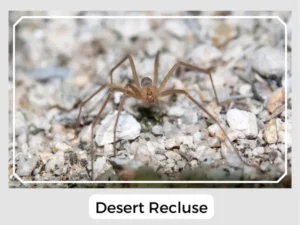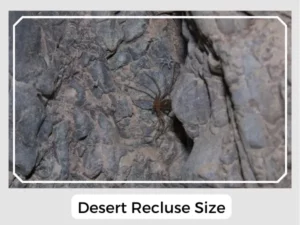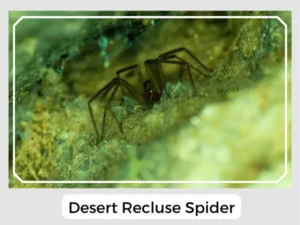Did you know there’s a spider called the desert recluse? It’s brown and is part of the Sicariidae family. People sometimes mix it up with another spider called the brown recluse, but they’re different and don’t live super close to each other. Stick around for some neat facts about the desert recluse!

Photo Credit: Sarah

Photo Credit: Sarah
The eggs are small and round in size.
The spiderlings of the desert recluse like most others detach from their mother in a span of a few days from hatching.
Their webs are irregular in shape and spun in areas that remain undisturbed. Moreover, these spiders of hunting origin do not weave webs in order to obtain their food.
Yes, Desert Recluse Spiders are venomous. They use their venom to help them catch their food, but it’s not too strong for humans.
Yes, Desert Recluse Spiders can bite. Their bite may be toxic, since it has a necrotic nature, damaging the skin as well as surrounding tissues severely, resulting in lesions that might take a considerable period of time for healing. Some people have also reported symptoms like nausea, fever, abdominal cramps, joint stiffness, headache, and fever.

Photo Credit: Sarah
The Desert Recluse plays a significant role in controlling insect populations in their arid habitat. As nocturnal hunters, they contribute to the balance of the desert ecosystem, preying on live insects and scavenging on deceased ones.
Natural Predators: The Desert Recluse faces predation from a variety of animals including birds, lizards, and other larger spiders. This predatory pressure helps regulate their numbers in the wild.
Prey-Predator Dynamics: The Desert Recluse is both predator and prey, impacting the populations of the insects it consumes and providing nourishment for its predators, which forms an integral part of the desert food web.
Relationship with Humans: While Desert Recluse spiders possess venom capable of causing significant tissue damage, they are not aggressive and tend to bite humans only when accidentally disturbed. Their bites can lead to necrotic lesions and systemic symptoms in some individuals, so caution is advised when in their presence.
| Lifespan | 1 to 3 years on average |
| Distribution | Nevada, Utah, Arizona, New Mexico, California, and parts of Mexico |
| Habitat | Mostly found outdoors amidst dense vegetation as well as dens of packrats, they hardly thrive indoors |
| Diet | Small live insects and sometimes even the dead ones. |
In summary, the Desert Recluse spider is an important arachnid in desert ecosystems, controlling pest populations and serving as prey for other wildlife.
Did you know there’s a spider called the desert recluse? It’s brown and is part of the Sicariidae family. People sometimes mix it up with another spider called the brown recluse, but they’re different and don’t live super close to each other. Stick around for some neat facts about the desert recluse!

Photo Credit: Sarah

Photo Credit: Sarah
The eggs are small and round in size.
The spiderlings of the desert recluse like most others detach from their mother in a span of a few days from hatching.
Their webs are irregular in shape and spun in areas that remain undisturbed. Moreover, these spiders of hunting origin do not weave webs in order to obtain their food.
Yes, Desert Recluse Spiders are venomous. They use their venom to help them catch their food, but it’s not too strong for humans.
Yes, Desert Recluse Spiders can bite. Their bite may be toxic, since it has a necrotic nature, damaging the skin as well as surrounding tissues severely, resulting in lesions that might take a considerable period of time for healing. Some people have also reported symptoms like nausea, fever, abdominal cramps, joint stiffness, headache, and fever.

Photo Credit: Sarah
The Desert Recluse plays a significant role in controlling insect populations in their arid habitat. As nocturnal hunters, they contribute to the balance of the desert ecosystem, preying on live insects and scavenging on deceased ones.
Natural Predators: The Desert Recluse faces predation from a variety of animals including birds, lizards, and other larger spiders. This predatory pressure helps regulate their numbers in the wild.
Prey-Predator Dynamics: The Desert Recluse is both predator and prey, impacting the populations of the insects it consumes and providing nourishment for its predators, which forms an integral part of the desert food web.
Relationship with Humans: While Desert Recluse spiders possess venom capable of causing significant tissue damage, they are not aggressive and tend to bite humans only when accidentally disturbed. Their bites can lead to necrotic lesions and systemic symptoms in some individuals, so caution is advised when in their presence.
| Lifespan | 1 to 3 years on average |
| Distribution | Nevada, Utah, Arizona, New Mexico, California, and parts of Mexico |
| Habitat | Mostly found outdoors amidst dense vegetation as well as dens of packrats, they hardly thrive indoors |
| Diet | Small live insects and sometimes even the dead ones. |
In summary, the Desert Recluse spider is an important arachnid in desert ecosystems, controlling pest populations and serving as prey for other wildlife.